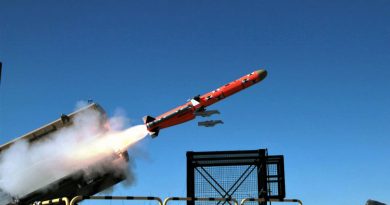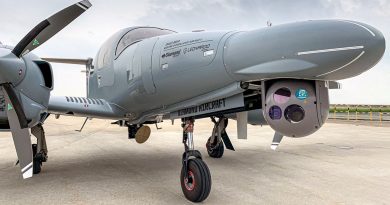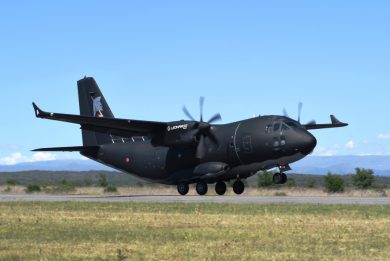Seafuture 2025 – Leonardo highlights main streams on multi-domain integrated solutions versus emerging threats
During Seafuture 2025 Leonardo presented how it intends responding to emerging threats with a multi-domain integrated solutions approach. Following the presentation EDR On-Line managed to get further information
“From High and Fast to Low and Slow”, this is how Matteo Cardone, Electronics Division Land & Sea Business Deputy Managing Director at Leonardo, summarised the widening of the threat spectrum, speaking at the “The evolution of future naval systems: meeting the technological challenge in multi-domain scenarios” conference, organised by the Italian MoD Naval Armaments Directorate during the Seafuture 2025 exhibition.
“The countering solutions we’re advancing today can be resumed in three main streams. The first is a system-of-systems solution that networks all the platforms across the various domains in a horizontal approach, no longer a vertical layer, to address the new, high-end threats, namely hypersonic and long-range ballistic missiles. The other key pillar is having sensors capable of supporting the detection and tracking of these threats and completing the engagement by supporting next-generation interceptors, like the Aquila solution by MBDA and the HYDIS² by the European consortium headed by the same company, or exo-atmospheric ones. The last solution, for mass-saturating unmanned air vehicles (UAVs), more commonly identified as swarm drone attacks, envisages a cost-effective solution that incorporates a series of sensors including radar and electro-optics, alongside a series of effectors, both kinetic and direct energy-based.
“Speaking about the system-of-systems solution, we need to pass from a kill chain to a kill web. The latter is the ability to network all the platforms, thus being able to use the sensors suite of all platforms in a classic engagement chain and choosing the best effector. This is no longer just an organic view of the platform, but rather having all the platforms of all domains networked and, with a web kill approach, deciding which is the best shooter, having any sensor at its disposal. Therefore, any sensor for the best shooter. This is only guaranteed by command-and-control nodes distributed across the various domains, capable of processing and sharing information. These nodes also have the ability to filter and network only the information needed by all the others, so as not to saturate the connection backbone,” Cardone highlighted.
“However, to further increase resilience and effectiveness, the new collaborative architecture would require artificial intelligence (AI)-powered features,” the Leonardo representative remarked, presenting a naval solution using AI algorithms. Cardone highlighted the activities being conducted with the command management system (CMS), and particularly those applied to the images collected by the optronic and direct-view conventional attack periscopes suite of the U212 Near Future Submarine (NFS). Cardone also unveiled how Leonardo is working to apply AI algorithms to the inverted synthetic aperture radar (ISAR) processing to provide a key interpretation aid for the operators.
Integrated Air and Missile Defence
The second stream was focused on the sensors designed or under development by Leonardo to counter ballistic and hypersonic threats.
“Today, the Italian Armed Forces and industry have developed systems and demonstrated the capability to engage up to 1300 km class ballistic missiles. Since 2017, the Italian MoD and Navy have participated to the NATO biannual Exercise Formidable Shield/At Sea Demonstration focused on Integrated Air and Missile Defence (IAMD). During the latest edition of May 2025 the crew of the Italian Navy MPCS/PPA Bande Nere, the first in the Full Combat configuration equipped with the Dual Band Radar (DBR) – with the C-band Kronos Quad and X-band Kronos StarFire four fixed faces AESA radars – successfully demonstrated ballistic missile defence (BMD) capabilities against both tactical and medium range missile threats,” the Leonardo representative highlighted.
During the final forum of the exercise, the Italian Navy was recognized as having one of the highest levels of IAMD capability, thanks to its C2, sensors and exchange tools with the most modern naval anti-air warfare assets among NATO and US naval forces, the company stated after the exercise conclusion.
“Thanks to the Leonardo SADOC 4 command-and-control system with IAMD capabilities, the ship contributed significantly to the shared situational awareness of the naval force involved in the exercise. Notably, the DBR radar suite detected and tracked a short-range ballistic target while maintaining tracking and disseminating data up to the point of impact at sea,” Cardone said, without providing further details. During FS 2025, an IAMD-T target with semi-guided capabilities was launched, and EDR On-Line understood this is the threat the Leonardo representative was referring to. “The Bande Nere crew and combat system also contributed to the naval task force situational awareness, acting as forward observer, independently identifying medium range ballistic targets launched from land and naval platforms at sea, and sharing their data in real time via data links,” he continued without further elaborating. During the exercise, two ARAV-B medium range targets were launched against the naval force and were intercepted by US Navy destroyers with SM-3 Block IA Standard missiles.
“In these occasions, the DBR demonstrated its ability to initialize tracking within seconds of launch and accurately track ballistic threats for hundreds of kilometres up to the final re-entry phase, and to detect and track high manoeuvring alongside very low cross section targets.”
“These capabilities were transferred by Leonardo to the land-based IAMD with the integration of the Kronos Grand Mobile High Power (GM-HP) radar with a single array of the 4FF Kronos Quad C-band radar into the SAMP/T NG ground-based air defence system, under delivery to the Italian and French forces. In parallel, the long-range air defence capabilities of the naval, fully digital L-band Kronos Power Shield AESA radar installed on the Trieste LHD – and Fincantieri-built Al Fulk LPD of the Qatar Emiri Naval Forces – saw the application to the mobile L-band BMD-capable long-range radar solution (Mobile Long-Range Radar, MLRR) being offered by Leonardo”, Cardone highlighted.
Leonardo is also addressing the need to counter hypersonic and medium-range ballistic missiles (2,000-3,000 km) threats with the development of respectively naval and land-based solutions. “After an initial feasibility and de-risking phase we are developing the new 4FF radar in the S-band which is to become the main anti air warfare sensor to be embarked on the new air defence destroyers for the Italian Navy under the DDX programme”, the Leonardo representative unveiled without providing further details.
“In the land domain, the technology bricks of the fully digital L-band Kronos Power Shield are applied to an early warning sensor solution called Ground-Based Radar (GBR) for national defence against hypersonic and ballistic missile threats with an antenna of circa 55 m2. Both the naval S-band and the land-based L-band solutions are targeted to be ready to provide the tracking data to support the new upper layer interceptors such as the Aquila and other exo-atmospheric missiles and supply accurate cues to lower layer surface-to-air missile systems,” the Leonardo representative explained. In the latest Italy’s Defence Programmatic Document (DPP) 2025-2027, a specific programme for an early warning capability in the BMD domain is specified with the reference to the procurement of four dedicated sensors capable to detect, track and identify the point of impact alongside the capability to provide data to a fire control centre for intercepting the threat. Based on the same full digital L-band radar technology solutions, Leonardo is developing for the Italian Government the Space Situational Awareness (SSA) capability based on a large flat array oriented towards the space to detect and track natural and man-made objects and provide a solid recognized space picture (RSP) contributing to the identification, classification and collision prevention as well as the defence activities in support of national space-based assets.
Counter drone technology solutions
The other development stream to which Leonardo is working are the counter unmanned air system (C-UAS) technologies and systems. This is based on a family of scalable and modular radar and electro-optic systems that can be installed on a wide range of platforms, together with the application of AI algorithms mainly related to the detection, recognition, and identification of drones. “We have a range of C- and X-band radars in service such as the DBR-X Kronos StarFire and the TMMR, while we are working on new developments such as the RAD-X (Evolution)”, Cardone said, without adding other details on the latter solution. EDR On-Line understood it refers to a new X-band array under development with enhanced form-fit-function and lower costs compared to current products. “Leonardo has also a scalable, high-performance, stabilized EO multi-sensor suite designed to deliver medium to long-range capabilities. Moving from the lower to the higher end, we propose the Janus digital version already available, a multi-domain long-range EO surveillance based on the LEOSS, and the DSS-IRST (Distributed Static and Staring – IRST),” the company representative highlighted referring to the naval domain. EDR-On Line understood a LEOSS-based solution is already under development and operational testing on board an Italian Navy platform.
On the countering capability side, speaking about kinetic solutions, the Leonardo representative presented the 30 mm X-Gun with air bust ammunitions (ABM) for multiple domains and the naval Lionfish 30 remotely controlled weapon system equipped with the same gun and presented for the first time at Seafuture 2025. Already contracted by the Italian Navy, the X-Gun was developed alongside the new 30 mm air burst ammunition (ABM) by KNDS Ammo Italy under the overall programme management of Leonardo for increasing the kill probability against drones and loitering ammunition. Cardone also presented the drone counter drone or drone catcher solution which was demonstrated under the European EDIDP JEY-CUAS programme as a cost-effective solution with radar-guided navigation enabling precise initial target approach and far intercept range.
With a lower Technology Readiness Level (TRL) but with a promising future are the Laser Direct Energy Weapons (L-DEWs) and the Radio-Frequency DEWs (RF-DEWs). “In the L-DEW segment we are working on two solutions: the first, in cooperation with our colleagues at MBDA, is the naval L-DEW on which we have already agreed on the objective in terms of power, lethality, and countered threats. We have already completed a proof of concept with an MBDA source and our beam director and already conducted firing tests with a 5 kW laser source. This is much less than the target we are aiming for but allowed to increase our systems awareness and validate our models.” The second solution regards a more powerful laser source in the 100 kW class. In December 2024, MBDA and Leonardo announced the signature of a MoU for the establishment of joint activities on a L-DEW. The latter regards a light fire unit, initially for maritime applications but later applicable also to the land domain. MBDA is the design authority for the existing naval platforms and uses a lower energy source, while a high-end fire unit with the design authority of Leonardo is intended for new shipbuilding. MBDA will develop the capability to generate high-power laser beams while Leonardo will create laser direction beamers and targeting point systems. Both companies are looking initially to the Italian Navy requirements, starting from the DDX programme, EDR On-Line understood.
Leonardo has also approached another type of effector, the less-mature but most promising solution for the defence against drone swarms, according to the company, the RF-DEW capability. Leonardo is exploring three different technological solutions providing each different capacity in terms of pulse duration and bandwidth: the Vircator (VIRtual Cathode OscillatOR), GaN array and GNLTL (Gyromagnetic Nonlinear Transmission Line).
All graphics courtesy Leonardo











